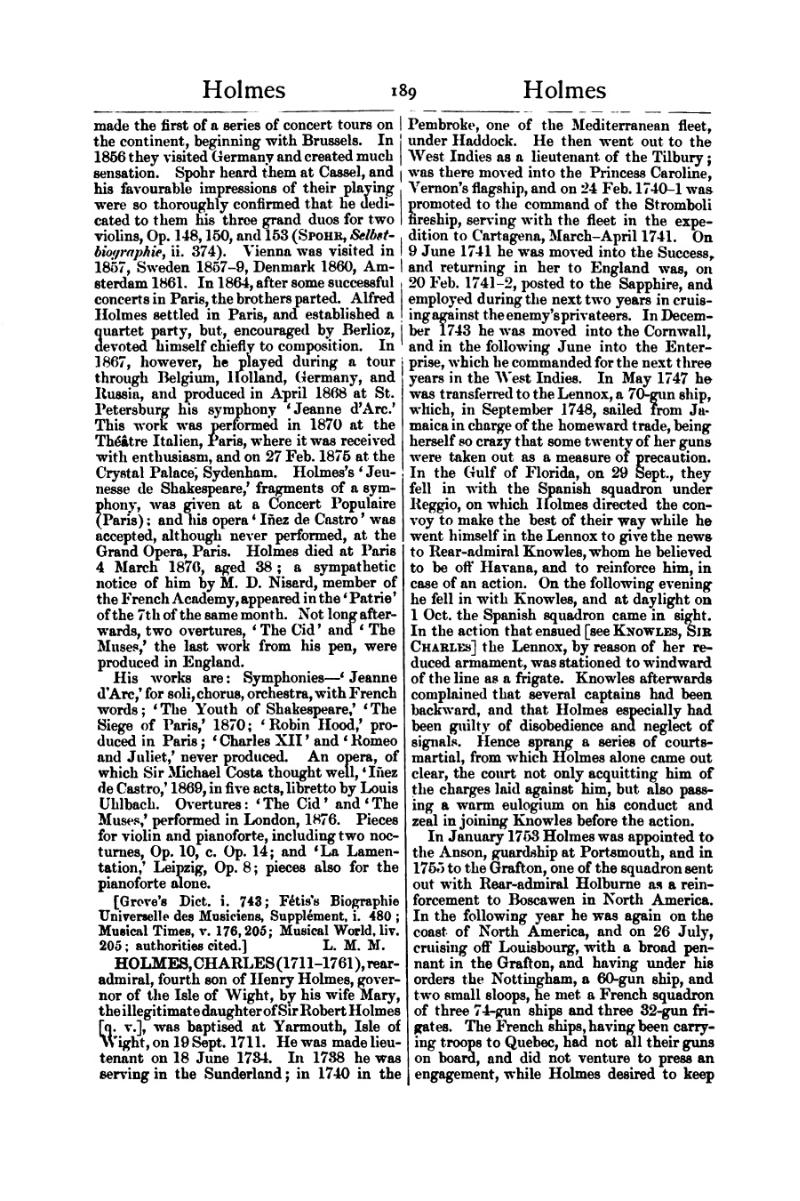made the first of a series of concert tours on the continent, beginning with Brussels. In 1856 they visited Germany and created much sensation. Spohr heard them at Cassel, and his favourable impressions of their playing were so thoroughly confirmed that he dedicated to them his three grand duos for two violins, Op. 148, 150, and 153 (Spohr, Selbstbiographie, ii. 374). Vienna was visited in 1857, Sweden 1857–9, Denmark 1860, Amsterdam 1861. In 1864, after some successful concerts in Paris, the brothers parted. Alfred Holmes settled in Paris, and established a quartet party, but, encouraged by Berlioz, devoted himself chiefly to composition. In 1867, however, he played during a tour through Belgium, Holland, Germany, and Russia, and produced in April 1868 at St. Petersburg his symphony ‘Jeanne d'Arc.’ This work was performed in 1870 at the Théâtre Italien, Paris, where it was received with enthusiasm, and on 27 Feb. 1875 at the Crystal Palace, Sydenham. Holmes's ‘Jeunesse de Shakespeare,’ fragments of a symphony, was given at a Concert Populaire (Paris); and his opera ‘Iñez de Castro’ was accepted, although never performed, at the Grand Opera, Paris. Holmes died at Paris 4 March 1876, aged 38; a sympathetic notice of him by M. D. Nisard, member of the French Academy, appeared in the ‘Patrie’ of the 7th of the same month. Not long afterwards, two overtures, ‘The Cid’ and ‘The Muses,’ the last work from his pen, were produced in England.
His works are: Symphonies—‘Jeanne d'Arc,’ for soli, chorus, orchestra, with French words; ‘The Youth of Shakespeare,’ ‘The Siege of Paris,’ 1870; ‘Robin Hood,’ produced in Paris; ‘Charles XII’ and ‘Romeo and Juliet,’ never produced. An opera, of which Sir Michael Costa thought well, ‘Iñez de Castro,’ 1869, in five acts, libretto by Louis Uhlbach. Overtures: ‘The Cid’ and ‘The Muses,’ performed in London, 1876. Pieces for violin and pianoforte, including two nocturnes, Op. 10, c. Op. 14; and ‘La Lamentation,’ Leipzig, Op. 8; pieces also for the pianoforte alone.
[Grove's Dict. i. 743; Fétis's Biographie Universelle des Musiciens, Supplément, i. 480; Musical Times, v. 176, 205; Musical World, liv. 205; authorities cited.]
HOLMES, CHARLES (1711–1761), rear-admiral, fourth son of Henry Holmes, governor of the Isle of Wight, by his wife Mary, the illegitimate daughter of Sir Robert Holmes [q. v.], was baptised at Yarmouth, Isle of Wight, on 19 Sept. 1711. He was made lieutenant on 18 June 1734. In 1738 he was serving in the Sunderland; in 1740 in the Pembroke, one of the Mediterranean fleet, under Haddock. He then went out to the West Indies as a lieutenant of the Tilbury; was there moved into the Princess Caroline, Vernon's flagship, and on 24 Feb. 1740–1 was promoted to the command of the Stromboli fireship, serving with the fleet in the expedition to Cartagena, March–April 1741. On 9 June 1741 he was moved into the Success, and returning in her to England was, on 20 Feb. 1741–2, posted to the Sapphire, and employed during the next two years in cruising against the enemy's privateers. In December 1743 he was moved into the Cornwall, and in the following June into the Enterprise, which he commanded for the next three years in the West Indies. In May 1747 he was transferred to the Lennox, a 70-gun ship, which, in September 1748, sailed from Jamaica in charge of the homeward trade, being herself so crazy that some twenty of her guns were taken out as a measure of precaution. In the Gulf of Florida, on 29 Sept., they fell in with the Spanish squadron under Reggio, on which Holmes directed the convoy to make the best of their way while he went himself in the Lennox to give the news to Rear-admiral Knowles, whom he believed to be off Havana, and to reinforce him, in case of an action. On the following evening he fell in with Knowles, and at daylight on 1 Oct. the Spanish squadron came in sight. In the action that ensued [see Knowles, Sir Charles] the Lennox, by reason of her reduced armament, was stationed to windward of the line as a frigate. Knowles afterwards complained that several captains had been backward, and that Holmes especially had been guilty of disobedience and neglect of signals. Hence sprang a series of courts-martial, from which Holmes alone came out clear, the court not only acquitting him of the charges laid against him, but also passing a warm eulogium on his conduct and zeal in joining Knowles before the action.
In January 1753 Holmes was appointed to the Anson, guardship at Portsmouth, and in 1755 to the Grafton, one of the squadron sent out with Rear-admiral Holburne as a reinforcement to Boscawen in North America. In the following year he was again on the coast of North America, and on 26 July, cruising off Louisbourg, with a broad pennant in the Grafton, and having under his orders the Nottingham, a 60-gun ship, and two small sloops, he met a French squadron of three 74-gun ships and three 32-gun frigates. The French ships, having been carrying troops to Quebec, had not all their guns on board, and did not venture to press an engagement, while Holmes desired to keep
